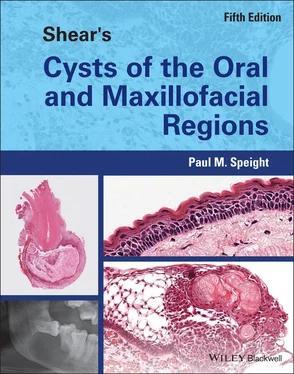Paul M. Speight - Shear's Cysts of the Oral and Maxillofacial Regions
Здесь есть возможность читать онлайн «Paul M. Speight - Shear's Cysts of the Oral and Maxillofacial Regions» — ознакомительный отрывок электронной книги совершенно бесплатно, а после прочтения отрывка купить полную версию. В некоторых случаях можно слушать аудио, скачать через торрент в формате fb2 и присутствует краткое содержание. Жанр: unrecognised, на английском языке. Описание произведения, (предисловие) а так же отзывы посетителей доступны на портале библиотеки ЛибКат.
- Название:Shear's Cysts of the Oral and Maxillofacial Regions
- Автор:
- Жанр:
- Год:неизвестен
- ISBN:нет данных
- Рейтинг книги:5 / 5. Голосов: 1
-
Избранное:Добавить в избранное
- Отзывы:
-
Ваша оценка:
- 100
- 1
- 2
- 3
- 4
- 5
Shear's Cysts of the Oral and Maxillofacial Regions: краткое содержание, описание и аннотация
Предлагаем к чтению аннотацию, описание, краткое содержание или предисловие (зависит от того, что написал сам автор книги «Shear's Cysts of the Oral and Maxillofacial Regions»). Если вы не нашли необходимую информацию о книге — напишите в комментариях, мы постараемся отыскать её.
Shear’s Cysts of the Oral and Maxillofacial Regions
Shear’s Cysts of the Oral and Maxillofacial Regions Fifth Edition
Shear's Cysts of the Oral and Maxillofacial Regions — читать онлайн ознакомительный отрывок
Ниже представлен текст книги, разбитый по страницам. Система сохранения места последней прочитанной страницы, позволяет с удобством читать онлайн бесплатно книгу «Shear's Cysts of the Oral and Maxillofacial Regions», без необходимости каждый раз заново искать на чём Вы остановились. Поставьте закладку, и сможете в любой момент перейти на страницу, на которой закончили чтение.
Интервал:
Закладка:
Philipsen et al. (2004 ) also suggested that the ages differ for males and females, with males affected slightly later. They showed that lesions on the first molar affect individuals with a mean age at presentation of 9.0 years for males (range 5–47; n = 24) and 8.1 years for females (range 6–11; n = 12). Lesions on the second molar presented with mean ages of 19.8 years for males (range 10–40; n = 8) and 13.6 years for females (range 12–16; n = 5). These differences were not shown to be significant and the higher mean age in males is almost certainly due to outlying single cases at an older age. Nevertheless, the data show that occasional cysts may persist undetected into later adulthood.
Paradental cysts on third molars present in an older age group ( Table 4.2). The mean age of presentation is about 28 years and all studies show a peak in the third decade. Two‐thirds (66.7%) of the cases in Craig's (1976 ) series arose in the third decade. In the study by Ackermann et al. (1987 ), 48 of the 50 cysts occurred between the ages of 10 years and 39 years, with 34 cases (68%) in the third decade. There was only one case in the fifth decade and one patient aged 62 years. Five of the six cases in the study of Fowler and Brannon (1989 ) affected patients in the third decade. In their review of the world literature, Philipsen et al. (2004 ) reported similar age distributions with a peak in the third decade (38% of cases) and a mean age of 27.6 years. The age range of lesions associated with third molars is wide, overall ranging from 11 to 74 years ( Table 4.2), again suggesting that occasional lesions may remain undetected and symptomless for long periods.
Inflammatory collateral cysts arising at other sites also reflect the age of eruption of the associated teeth: the four premolar cases reported by Morimoto et al. (2004 ) presented at ages 9 or 10 years, and 7 of the 8 cases reported in the globulomaxillary region were found between the ages of 10 and 19 years (Vedtofte and Holmstrup 1989 ).
Sex
Inflammatory collateral cysts show a slight preponderance for males, but this is most apparent for paradental cysts ( Table 4.2), where about 70% of cases overall affected males. Mandibular buccal bifurcation cysts affecting children show a more even distribution between males and females ( Table 4.3), with only one series reporting a male preponderance (70%: Thurnwald et al. 1994 ). Philipsen et al. (2004 ) found 87 cases where sex had been recorded, with a slight male preponderance of 55%. In their analysis of odontogenic cysts, Jones et al. (2006 ) found 14 cases in children where sex was recorded and showed a male : female ratio of 1.33 (57% males).
Site
Inflammatory collateral cysts are almost exclusively found in the mandible and over 60% are paradental cysts involving a mandibular third molar. Only a handful of cases have been reported in the maxilla. In the original description of the lesion, Main (1970 ) described 1 case associated with an upper canine and Vedtofte and Holmstrup (1989 ) subsequently reported a series of 8 cases arising between the upper canine and second incisor (globulomaxillary region). In their large review, Philipsen et al. (2004 ) found that 97.3% of cases arose in the mandible, with only 10 (2.7%: including the 8 cases of Vedtofte and Holmstrup) in the maxilla. Jones et al. (2006 ) found 402 inflammatory collateral cysts in their files, but only 1 case was recorded in the maxilla, associated with a third molar. Ochsenius et al. (2007 ) found 113 paradental cysts in their series of odontogenic cysts, 6 (5.3%) of which were associated with maxillary third molars. The 4 premolar cases reported by Morimoto et al. (2004 ) were all in the mandible.
Paradental cysts are located almost exclusively on mandibular third molars, but 2 cases have been recorded on second molars when the third molar is absent and the second molar is the last standing tooth (see later Figure 4.2; Vedtofte and Praetorius 1989 ; de Sousa et al. 2001 [2 cases]; Maruyama et al. 2015 ). These unusual examples arose at an average age of 14.5 years (range 13–17 years), but were otherwise identical to paradental cysts encountered on third molars.
Mandibular buccal bifurcation cysts are located on the first or second molar teeth, but the relative frequency of occurrence on each tooth is rarely reported. In the review by Philipsen et al. (2004 ), cysts on the first and second molars were usually reported together, but for 49 cases the site distribution was known. Of these cases, 36 (73.5%) were located on first molars and 13 (26.5%) on second molars. This suggests that mandibular buccal bifurcation cysts are about twice as common on first molars as on second molars.
Inflammatory collateral cysts may be bilateral, but this is more common for the mandibular buccal bifurcation cyst than for paradental cysts. Case series have shown that between about 16 and 40% of mandibular buccal bifurcation cysts present as bilateral lesions ( Table 4.3), while bilateral lesions are only seen in about 4% of patients with paradental cysts ( Table 4.2)
Clinical Presentation
Over 60% of all inflammatory collateral cysts are paradental cysts involving mandibular third molar teeth with a history of recurrent or persistent pericoronitis, although lesions may be symptomless at presentation. The third molar is always partially or recently erupted and most are impacted. In Craig's (1976 ) series of 48 patients, all cases were associated with a history of pericoronitis, but bony expansion or swelling was not a feature and most lesions were chance findings on extraction of the impacted tooth. Ackermann et al. (1987 ), Fowler and Brannon (1989 ), and Colgan et al. (2002 ) found that all their cases were associated with a partially erupted third molar with a history or presence of pericoronitis. Symptoms of pain or swelling were rarely encountered, although there may be signs of persistent infection. On examination, all lesions are found on the buccal side of the tooth and most are orientated towards the distal aspect. On probing, the cyst lumen is usually found to communicate with the associated periodontal pocket or with the pericoronal space beneath the inflamed operculum. As mentioned previously, a paradental cyst may arise on a second molar when it is the last standing tooth in the mandible. This is rare, but when it occurs the clinical and radiological features are identical to a paradental cyst arising on a third molar (Vedtofte and Praetorius 1989 ; de Sousa et al. 2001 ; Maruyama et al. 2015 ).
In contrast to the paradental cyst, the mandibular buccal bifurcation cyst usually presents with symptoms – most often a complaint of swelling, with pain or tenderness. Stoneman and Worth (1983 ) first reported this lesion as ‘mandibular infected buccal cyst’, and although some cases produced few or no clinical symptoms, they felt that the lesion was characterised by signs of infection, including discomfort, pain, tenderness, and painful occlusion. Rarely, there may be suppuration with formation of a facial abscess that may point ( Figure 4.1). Swelling and pain are the clinical features most likely to induce the patient to seek advice.
Pompura et al. (1997 ) reported 32 patients with cysts on mandibular first molars and found that all cases presented with pain or tenderness in the affected area. Only 14 patients (43.7%) were aware of swelling of the cheek, but in the remaining 18 cases intraoral swelling of the alveolus was evident on clinical examination. A foul‐tasting discharge consistent with infection was reported by 20 patients (62.5%). Vedtofte and Praetorius (1989 ) reported 12 cases associated with first or second molars and found that the most common symptoms were pain and swelling associated with discharge of pus. In all cases the cyst lumen communicated with the periodontal pocket on the buccal aspect of the tooth. Philipsen et al. (2004 ) reported that buccal swelling was rarely associated with cysts on the second molar, but is a characteristic feature of lesions on the first molar.
Читать дальшеИнтервал:
Закладка:
Похожие книги на «Shear's Cysts of the Oral and Maxillofacial Regions»
Представляем Вашему вниманию похожие книги на «Shear's Cysts of the Oral and Maxillofacial Regions» списком для выбора. Мы отобрали схожую по названию и смыслу литературу в надежде предоставить читателям больше вариантов отыскать новые, интересные, ещё непрочитанные произведения.
Обсуждение, отзывы о книге «Shear's Cysts of the Oral and Maxillofacial Regions» и просто собственные мнения читателей. Оставьте ваши комментарии, напишите, что Вы думаете о произведении, его смысле или главных героях. Укажите что конкретно понравилось, а что нет, и почему Вы так считаете.












